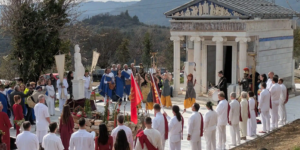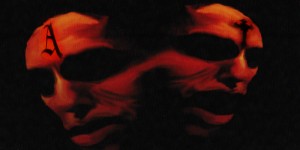 I was born and raised in an Italian Catholic family, but I was never convinced by that ideology. After about 8 years of attentive study of both Christian and Hindu texts, I officially converted to Hinduism in 1978, and I have been a very active, dedicated, vocal and unapologetic Hindu since.
I was born and raised in an Italian Catholic family, but I was never convinced by that ideology. After about 8 years of attentive study of both Christian and Hindu texts, I officially converted to Hinduism in 1978, and I have been a very active, dedicated, vocal and unapologetic Hindu since.
In 1984, I started travelling around India, learning from many sadhus and gurus, and from 1994 to 2019, I lived in the holy dhama of Jagannatha Puri, Orissa, also undergoing the official rituals of suddhi and diksha under the direction of the deula purohita of Jagannatha temple.
So, forgive me if I don’t get all emotional and sad about the recent death of Pope Francis, the first of the name. Jorge Mario Bergoglio, born in Argentina 88 years ago, died of a  stroke in the early hours of Easter Monday, 21st April, 2025. He was elected Pope on 13th March 2013, and previously he had been the
stroke in the early hours of Easter Monday, 21st April, 2025. He was elected Pope on 13th March 2013, and previously he had been the
Jesuit provincial superior from 1973 to 1979 – a position usually referred to as “the black pope”, to signify the enormous albeit hidden  political power in the absolute authority of the Jesuits.
political power in the absolute authority of the Jesuits.
Bergoglio had been closely connected to dictators (Argentina) and Augusto Pinochet Ugarte (Chile), who was also extremely friendly with the main supporter of Bergoglio, Pope John Paul II (second of the name), born as Karol  Josef Wojtyla, under whom we saw the famous scandal of Stanislaw Wielgus, the Cardinal who was exposed as an agent of the Polish espionage connected to theKGB.
Josef Wojtyla, under whom we saw the famous scandal of Stanislaw Wielgus, the Cardinal who was exposed as an agent of the Polish espionage connected to theKGB.
Francis’ predecessor, Benedict XVI (16th of the name), was the German-born Joseph Alois Ratzinger, who was elected pope in 2005 (at the death of Pope Jon Paul II), “resigned” in 2013 and died in 2022.
The particularly weird fact about this resignation is that Benedict XVI remained “pope emeritus” until his death in 2022. The official photo opportunities showed great camaraderie and good feelings between the two simultaneous Popes, but some expert commentators (such as journalist Andrea Cionci) have highlighted a few very suspicious facts that would show a very different picture.
 Benedict XVI had been (1982–2005) the head (Prefect) of the Congregation for the Doctrine of the Faith, previously known as “Supreme Sacred Congregation of the Roman and Universal Inquisition”, and President of the International Theological Commission (1982–2005), just until his official election as Pope.
Benedict XVI had been (1982–2005) the head (Prefect) of the Congregation for the Doctrine of the Faith, previously known as “Supreme Sacred Congregation of the Roman and Universal Inquisition”, and President of the International Theological Commission (1982–2005), just until his official election as Pope.
Many people within the Catholic Church never accepted the election of Francis and rather considered him as an “anti-pope” (as in the famous period of the Avignone anti-Popes), because it seems that Benedict never really abdicated but was forced to step aside (sede impedita) rather than genuinely stepping away (sede vacante).
 Benedict was extremely proficient in the official language of the Catholic Church, ecclesiastic Latin, yet experts such as Gian Matteo Corrias and Luciano Canfora have found over 40 unexplained serious irregularities, apparently inserted deliberately to invalidate the document.
Benedict was extremely proficient in the official language of the Catholic Church, ecclesiastic Latin, yet experts such as Gian Matteo Corrias and Luciano Canfora have found over 40 unexplained serious irregularities, apparently inserted deliberately to invalidate the document.
The time indicated in the declaration is also strangely incorrect. Commentators have argued that the misleading calculation of the hour for the opening of the conclave
consultations would technically invalidate the entire process of the election of a new pope.
Furthermore, other deliberate irregularities were evident: in the declaration, Benedict only renounced the magisterium (functions) and not the munus (position) as well – also ostensibly continuing to live in Vatican City, wearing the typical papal white cassock etc, so much that the Vatican had to accept a weird compromise by calling him “pope emeritus”. There was also some confirmation by Benedict himself to the German journalist Peter Seewald, who wrote several books about him, and in an interview specifically asked him about the issue.
 Another interesting factor that has sparked some controversy and speculations refers to the famous prophecy of Saint Malachy, a very important bishop who was the close friend and successor of Patrick in the position of leader of the Church of Ireland (around 1100 CE).
Another interesting factor that has sparked some controversy and speculations refers to the famous prophecy of Saint Malachy, a very important bishop who was the close friend and successor of Patrick in the position of leader of the Church of Ireland (around 1100 CE).
Malachy was made a saint by the Vatican because of his numerous miracles and tireless missionary zeal, prompting him to fight not only against the pagans, but also against deviations and corruption in the early Church after Patrick’s demise.
Malachy was also the bosom (literally) friend of Saint Bernard de Clairvaux, founder of the very strict monastic order of the Cistercensians and the spiritual leader of the founders of the Knights Templar. Malachy died in the arms of Bernard, and they were buried together.
 In his prophecies, Malachy offers a list of 112 popes, starting from Celestine II (the 2nd), who reigned from 1143 to 1144, when he abdicated and was assassinated shortly thereafter.
In his prophecies, Malachy offers a list of 112 popes, starting from Celestine II (the 2nd), who reigned from 1143 to 1144, when he abdicated and was assassinated shortly thereafter.
The last of the 111 popes is believed to be Benedict XVI, after which the Catholic Church would be ruled by a “Peter Romanus” through a period of extreme persecution culminating in his assassination and the complete destruction of the city of Rome and the Church. Francis is not mentioned at all, which some people believe confirms he was not a Pope, but rather an anti-Pope.
Some people also noticed that Benedict “resigned” in March 2013, precisely 700 years after the last Grand Master of the Templars, Jacques de Molay, had been burned at the stake, cursing the then  King of France (Philip IV) and the then Pope (Clement V) to die within a year (which they did, one of a hunting accident and the other of a stroke) as well as cursing the entire Capetian dynasty (which perished completely within 14 years after over 300 years of undisputed reign) and the entire Church that would be totally annihilated after 700 years of his own death.
King of France (Philip IV) and the then Pope (Clement V) to die within a year (which they did, one of a hunting accident and the other of a stroke) as well as cursing the entire Capetian dynasty (which perished completely within 14 years after over 300 years of undisputed reign) and the entire Church that would be totally annihilated after 700 years of his own death.
Of course, the official version is that these prophecies are a (relatively recent) forgery, as they were published only in 1595, but that time frame also presents some interesting facts. On 27 September 1540, the famous Company of Jesus (the Jesuits) was founded by Ignatius of Loyola and Francis Xavier together with a few other comrades (Peter Faber, Nicholas Bobadilla, Diego Laínez, Simão Rodrigues and Alfonso Salmeron).
 Another important figure of that period was Saint Philip (Filippo) Neri (1515- 1595), who is sometimes referred to as “the second apostle of Rome” after Peter. Filippo Neri was a very prominent champion of the Church of Rome, and as such he has been long venerated by the Catholics of England, persecuted by the Protestant government since Henry VIII.
Another important figure of that period was Saint Philip (Filippo) Neri (1515- 1595), who is sometimes referred to as “the second apostle of Rome” after Peter. Filippo Neri was a very prominent champion of the Church of Rome, and as such he has been long venerated by the Catholics of England, persecuted by the Protestant government since Henry VIII.
He was a very close friend of Loyola and the other founders of the militant Company of Jesus, and many of his own disciples joined the Jesuits.
Filippo was eager to travel to India to become a missionary there, but his companions convinced him there was a lot of work to do in Europe as well.
So he went on to invent an order of “secular priests”
called “the Congregation of the Oratory”. He was also quite involved in politics, brokering a brilliant
strategy for the pope towards the then-king of France, Henry IV. We could be excused for thinking that  the “prophecies of Malacy” are still quite interesting, and not to be dismissed as “mere forgery” even if they were written by some Jesuit in the 1500s rather than by the head of Catholic Ireland in the 1100s. We can expect this, and more. John Adams, who wrote a 4-volume history of the Jesuits, states:
the “prophecies of Malacy” are still quite interesting, and not to be dismissed as “mere forgery” even if they were written by some Jesuit in the 1500s rather than by the head of Catholic Ireland in the 1100s. We can expect this, and more. John Adams, who wrote a 4-volume history of the Jesuits, states:
“This society has been a greater calamity to mankind than the French Revolution, or Napoleon’s despotism or ideology. It has obstructed the progress of reformation and the improvement of the human mind in society much longer and more fatally.”
Many great statesmen have explicitly expressed similar if not worse, judgments, although you really need to dig deep into the information available to the public in order to find out, because the official propaganda presents the Jesuits as very liberal, tolerant, wise, charitable and saintly men.
An impressive number of statesmen, researchers and experts have expressed scathingly negative opinions about the ideology and methods of the Jesuits, “the (military order of the) Company of Jesus”.
Among those very outspoken critics, Napoleon Bonaparte, the Marquis de la Fayette, Abraham Lincoln, Thomas Jefferson, Richard W Thompson (Secretary of US Navy), the Archduke Maximilian Francis, Fyodor Dostoyevsky, Madame Helena Blavatsky, and Luigi Desanctis (the official Censor of the Inquisition).
Among the historians who denounced the scheming of Jesuits were Edmond Paris, J E C Shepherd, Stewart Menzies, Nino Lo Bello, Dave Hunt, Friedrich von Hardenberg, Samuel F B Morse, Michael AngeloTamburini, Leo H Lehmann, John Daniel Middleton, Simon Schama, James Burke, Eric J Phelps, Avro Manhattan, Alberto Rivera, Malachi Martin, and Robert J Breckinridge, who wrote for example:
“The Society of Jesus is the enemy of man. The whole human race should unite for its overthrow.”
Even the dictionary, the Concise Oxford Dictionary of the English language, lists “equivocating” as a
secondary denotation of the word “Jesuit”.
In Switzerland, the constitution was modified and Jesuits were banished in 1848, following the defeat of
the Sonderbund Catholic defence alliance. The ban was lifted on 20 May 1973, when 54.9 per cent of
voters accepted a referendum to that effect.
 The Jesuits were temporarily banished from France in 1594 after a Jesuit follower, Jean Châtel, tried to assassinate the King of France, Henri IV. Other Jesuits are known to have been directly involved in violent political schemes, such as Henry Garnet and Oswald Tesimond, who orchestrated the famous Gunpowder Plot (1605) to assassinate the entire royal family and most of the Protestant aristocracy by blowing up the Houses of Parliament.
The Jesuits were temporarily banished from France in 1594 after a Jesuit follower, Jean Châtel, tried to assassinate the King of France, Henri IV. Other Jesuits are known to have been directly involved in violent political schemes, such as Henry Garnet and Oswald Tesimond, who orchestrated the famous Gunpowder Plot (1605) to assassinate the entire royal family and most of the Protestant aristocracy by blowing up the Houses of Parliament.
In 1759 the Catholic Church itself expelled the Jesuits from most countries in Europe and from European colonies. Pope Clement XIV officially suppressed the order in 1773, however, in 1814, the Church lifted the suppression. It seems that around that period, the Jesuits successfully infiltrated the ancient Masonic lodges and took considerable power inside the Illuminati movement.
Jesuit missionaries established missions around the world straight from the 1500s for the purpose of
controlling and christianizing the native peoples and shaping their local governments, as well as
engineering the proper misinformation and disinformation campaigns to “manufacture consent” among all classes of society. The very term Propaganda is a very popular word from the Latin expression
“propaganda fidei”, meaning “that which should be propagated about the faith”, in other words: the official version that must be made to believe by the public. The Jesuits are the most expert masters at this art.
By the time of Ignatius’ death in 1556, the Jesuits were already operating a network of 74 colleges on
three continents, as the basic academic education is the best instrument to indoctrinate and control
 societies by mixing biased religious and cultural misinformation with impressive academic quality on many useful subjects.
societies by mixing biased religious and cultural misinformation with impressive academic quality on many useful subjects.
In addition to the teachings of the Catholic faith, the Jesuit Ratio Studiorum (1599) standardised the study of Latin, Greek, classical literature, poetry, and philosophy as well as non-European languages,
sciences, and the arts. Furthermore, Jesuit schools encouraged the study of vernacular literature and rhetoric, and thereby became important centres for the training of lawyers and public officials.
One of the original seven, Francis Xavier, arrived in India in 1541, precisely in Goa, and in a
1545 letter to King John III of Portugal, he requested the Inquisition to be installed in Goa, and went on
 dispossessing, torturing, enslaving and killing thousands, until mercifully the Jesuits were expelled from Portuguese territories in 1759 by the powerful Marquis of Pombal, Secretary of State in Portugal.
dispossessing, torturing, enslaving and killing thousands, until mercifully the Jesuits were expelled from Portuguese territories in 1759 by the powerful Marquis of Pombal, Secretary of State in Portugal.
From their very start in the 1500s onwards, Jesuits were also actively engaged in the trade in enslaved natives of
all the territories they could reach.
Andrew Dial has calculated that in 1760, the Jesuits owned more than 20,000 slaves (not counting those they had sold). In the United States, tobacco plantations utilising African-American slave  labour in Maryland and other states actively supported Jesuit institutions such as Georgetown University, which infamously sold 272 slaves in 1838.
labour in Maryland and other states actively supported Jesuit institutions such as Georgetown University, which infamously sold 272 slaves in 1838.
The Jesuits justified their own ownership of slaves and participation in the slave trade as a means of converting slaves to Catholicism. “Enslaved people… are a captive audience for evangelization”.
The Jesuits have long been dominating and controlling the entire Catholic Church, beginning with the Popes themselves: each Pope must have a personal confessor who must be a Jesuit.
 The head of the Jesuits is famously called “the Black Pope”, because he is the real power behind the cathedra of the official pontiff. With Francis the first (did he take his name after Francis Xavier?), the distinction between the “black Pope” and the “official Pope” has been breached. One of the most famous quotes of Pope Francis is, “Jesuits make a vow of obedience to the pope… but if the pope is a Jesuit, perhaps he has to make a vow of obedience to the General of the Jesuits!… I feel a Jesuit in my spirituality, in the spirituality of the Exercises, the spirituality deep in my heart.”
The head of the Jesuits is famously called “the Black Pope”, because he is the real power behind the cathedra of the official pontiff. With Francis the first (did he take his name after Francis Xavier?), the distinction between the “black Pope” and the “official Pope” has been breached. One of the most famous quotes of Pope Francis is, “Jesuits make a vow of obedience to the pope… but if the pope is a Jesuit, perhaps he has to make a vow of obedience to the General of the Jesuits!… I feel a Jesuit in my spirituality, in the spirituality of the Exercises, the spirituality deep in my heart.”
 The Pope is (at least theoretically) considered the absolute authority for about 1.4 billion Catholics, and the King of the independent State of the Vatican, which is officially described as a Unitary theocratic Catholic elective absolute monarchy. The Vatican has 882 citizens and permanent residents, mostly clergy members, and it never became a member of the United Nations – although it has a permanent observer status with all the rights of a full member except for a vote in the UN General Assembly (which they do not care about anyway).
The Pope is (at least theoretically) considered the absolute authority for about 1.4 billion Catholics, and the King of the independent State of the Vatican, which is officially described as a Unitary theocratic Catholic elective absolute monarchy. The Vatican has 882 citizens and permanent residents, mostly clergy members, and it never became a member of the United Nations – although it has a permanent observer status with all the rights of a full member except for a vote in the UN General Assembly (which they do not care about anyway).
 Francis the 1st was very popular, as he did quite well in his job of public relations to save the image of The Catholic Church, to contrast and balance the extremely conservative approach of his predecessor Benedict XVI, who did not shy away from emphasising the extreme opulence of the Church, itsintolerance and cruelty towards women and children, non-binary persons and non-Catholics, and his
Francis the 1st was very popular, as he did quite well in his job of public relations to save the image of The Catholic Church, to contrast and balance the extremely conservative approach of his predecessor Benedict XVI, who did not shy away from emphasising the extreme opulence of the Church, itsintolerance and cruelty towards women and children, non-binary persons and non-Catholics, and his
open protection for pedophile and criminal clergy.
Obviously, the Jesuits had clearly understood that especially in modern times the Church could not afford to lose too many supporters and well-wishers, so Francis made all possible efforts to portray a humble,a renounced, tolerant, kind, inclusive, understanding and jolly looking man who even had a good sense of humor – some noted the resemblance with the famous comedian Stan Laurel, of the old pair Laurel & Hardy featuring in many silent movies.
 The official propaganda has strongly highlighted a few occasions in which Pope Francis “apologised” for the crimes committed by the Church against native peoples, women, children, and other victims of its brutality.
The official propaganda has strongly highlighted a few occasions in which Pope Francis “apologised” for the crimes committed by the Church against native peoples, women, children, and other victims of its brutality.
He was not the first to cave under the pressure of public opinion in favour of human rights. In 1993, the
Indigenous Law Institute called on Pope John Paul II to revoke Inter caetera and to make reparation for
“This unreasonable historical grief”. This was followed by a similar appeal in 1994 by the Parliament of World Religions.
 So after quite some deliberation, in 2000, Pope John Paul II made a sweeping apology for the Catholic Church’s actions (“sins”, carefully note the expression) throughout history, including those related to the Inquisition. This apology acknowledged the violence and persecution inflicted on various groups, including Jews, heretics, and others deemed heretical, during the Inquisition. The Pope also expressed remorse for the wrongs committed against indigenous peoples and for the Church’s involvement in the Holocaust.
So after quite some deliberation, in 2000, Pope John Paul II made a sweeping apology for the Catholic Church’s actions (“sins”, carefully note the expression) throughout history, including those related to the Inquisition. This apology acknowledged the violence and persecution inflicted on various groups, including Jews, heretics, and others deemed heretical, during the Inquisition. The Pope also expressed remorse for the wrongs committed against indigenous peoples and for the Church’s involvement in the Holocaust.
 On July 25, 2022, in Maskwacîs, Alta, Pope Francis apologised on behalf of the Roman Catholic Church for its role in the residential school system in North America.
On July 25, 2022, in Maskwacîs, Alta, Pope Francis apologised on behalf of the Roman Catholic Church for its role in the residential school system in North America.
One needs to actually understand the Jesuits’ mentality to see beyond such false apologies: acknowledging persecution does not amount to condemning it, and a “sin” is only an act of disobedience towards the laws of God – who especially in the Old Testament openly endorses or even commands genocide, torture, murder, slavery, looting, wanton destruction etc etc.
And what good is an apology for the actions committed by those people that you continue to venerate
and worship as SAINTS, precisely for the MERIT of committing such actions?
A sincere apology should include the recognition that those who committed those crimes were not “good Christians”, what to speak of being “saints”, and removing all the unethical passages in the Bible that incite such crimes. And stopping all overt and covert instigation to hatred and false propaganda against the categories that the Church has been persecuting for at least 1700 years. But of course, you cannot scrub the black off a piece of coal, can you?
Native Americans say Junípero Serra enslaved them; Pope Francis says he saved them
The Kurukshetra of Our Times
Hinduism, Hindutva, Hindu Rashtra
Removing abrahamic superimpositions from Hinduism
ISKCON Origins : History and Development
Devas Are Not ‘Demi Gods’ : So Get Over It !
Narendra Modi and Hindu Resurgence
Seeing Hinduism with Clarity
The Kama Sutra : Beyond the Sex
Junípero Serra to Francis Xavier : The ‘Saintly’ Vatican Criminals
Academic Approach Versus Vedic Approach : Part 1
Academic Approach Versus Vedic Approach : Part 2
UK : Catholic Church Bans Yoga Class
Hindu forgetfulness over ‘ Saint’ Francis Xavier’s activities in India
Hindus back Canadian aboriginals’ demand of Pope’s apology for Church’s role in “cultural genocide
Video Vivek Ramaswamy Gets Told “Hinduism Is A Wicked, Pagan Religion”
The Genesis of Racism in the Church
Prime Minister Modi and Pope Francis Must Work on a Declaration against Hinduphobia































